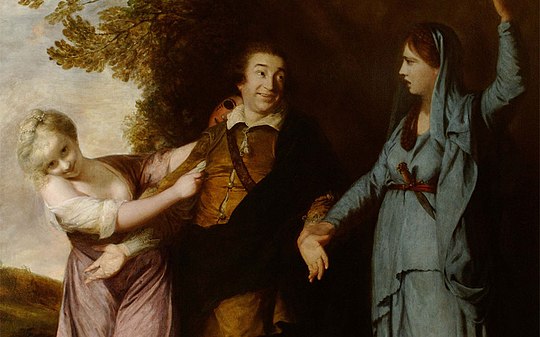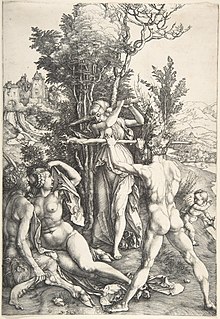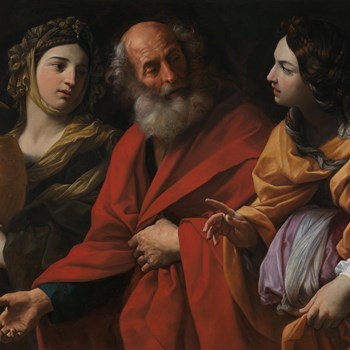You maybe often see this meme circulated elsewhere on the internet: a man walks with his girlfriend but turns his head backward because he’s distracted by another seductive woman. This photograph turns into a metaphor for almost everything from food, job, love relationship, film to ideology.

Antonio Guillem/Shutterstock. ‘Distracted Boyfriend’.
But, do you know an English 18th-century artist–Joshua Reynolds had painted a similar composition? Reynolds’ painting was entitled David Garrick Between Tragedy and Comedy (1761). It depicts David Garrick–an actor and playwright, between two muses of tragedy and comedy. The muse of tragedy is known as Melpomene, who grabs Garrick’s wrist and shows a displeased mimic. Meanwhile, the muse of comedy, known as Thalia, seductively pulls on Garrick’s arm.

Joshua Reynolds, David Garrick Between Tragedy and Comedy (1761). https://www.wikiwand.com/
Thalia is painted in front of bright sky, field, and bushes, while Melopemene is in dark and plain color. Another salient difference is Thalia wearing a mauve color dress drawn in the rococo style, while Melopemene is in a blue dress painted in the neoclassical style. These differences suggest their nature as the muses, a group of sister goddesses. Thalia or the muse of comedy is usually portrayed seated in humorous or erotic poses. She is believed to bring joy. Melopemene or the muse of tragedy often carries the tragic mask and a sword. She is depicted as if in mourning.
This painting is a parody of Hercules at The Crossroads or The Judgment of Hercules that illustrates young Hercules have to choose between Vice and Virtue. Vice suggests the life of pleasure but also immorality and sin, while Virtue is the life of hardship, honor, and moral excellence. In Greek mythology, Hercules chooses Virtue. This scene is a popular motif in western early modern art, for example, Albrecht Dürer’s Hercules at the Crossroads (1498). However, Reynolds has turned the story, Garrick tends to be interested in the muse of comedy.

Albrecht Dürer, Hercules at the Crossroads (1498). https://en.wikipedia.org/wiki/
David Garrick–the subject in Reynold’s painting was an English actor, poet, playwright, theatre manager, and producer. Garrick’s association with the Muses of Tragedy and Comedy can be found in William Whitehead’s 1747 poem. Garrick was also mentioned in Jean Paul Friedrich Richter’s 1797 writing The Campaner Thal.
The historian supposed the painting composition was inspired by Guido Reni’s Lot and his Daughters Leaving Sodom. Guido Reni was an Italian Baroque painter. His painting depicts biblical scenes when Lot and his family led by the angels leave Sodom that will be swept away.

Guido Reni, Lot and his Daughters Leaving Sodom. https://www.nationalgallery.org.uk/
The young Reynolds attended the Plympton grammar school and became familiar with the writings of classical antiquity. In the early period of his career, Reynolds was apprenticed for four years in London to Thomas Hudson, a conventional portraitist. Reynolds then established himself as a portrait painter. He studied ancient and Italian renaissance art, the work of Rembrandt, Rubens, and Van Dyck. David Garrick Between Tragedy and Comedy (1761) is mentioned as Reynolds’s “first attempt in historical composition”.
Like many other symbols in the world, the meaning of the ‘distracted boyfriend’ depiction has changed from time to time. It is embedded and moves across many contexts from mythology, visual and performance art, literature, to entertainment. This depiction is also not free from criticism as the image shows sexism. This criticism can also be seen as an attempt to interpret the image. The meaning is always changed depending on the culture and social context. So, what do you think about the ‘distracted boyfriend’?

